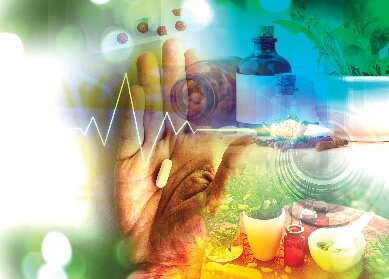There is an increase in the public awareness about complementary and alternative medicine (T/CAM). According to the reports, about half the population of many industrialized countries now use herbal medicine. More than 80% of the world population uses medicines made from herbal & natural products (World Health Organization Statistics). Studies also state that 80% of the population relies on traditional medicine in many developing countries (3). Most research concentrate on experimental medicine and regulatory issues. There is high interest in practicing alternative and herbal medicine by physicians. Some therapies are already being used by the physicians, and training is required in most areas (4). Reports from the UAE show that the residents have faith and confidence in herbal medicines (2). Global market of herbal and ayurvedic medicines is estimated to be more than US$ 100 billion, wherein European Union accounts for about 40%, Japan 20%, USA 10% (1).
Certain herbals are commonly used by patients for pain management practice. In the primary healthcare there is no significant reporting with regard to potential side effects, and drug interactions (5). A study conducted to explore the attitude of physicians toward complementary or alternative medicine shows that more than 70 to 90 percent of the physicians considered complementary medical therapies to be authentic. They also believe that significant rules should apply to orthodox medicine and to alternative medicine. Alternative medicine is a growing industry. Practitioners of alternative forms of medicine are becoming increasingly visible in many developed and developing countries (4). Asian countries account for the 30% of the alternative medicine global market (1). On a broader point of view, to maximize the impact of alternative and herbal medicine practice to health care systems globally; public health research must consider the social, cultural and economic aspects.
References
- Sheth, P. P. (2005). Global opportunities and challenges for medicinal uses of ayurveda, herbal products, neutraceuticals and alternatives. Health Administrator, 1, 74-75.
- AlBraik, F. A., Rutter, P. M., & Brown, D. (2008). A cross‐sectional survey of herbal remedy taking by United Arab Emirate (UAE) citizens in Abu Dhabi. Pharmacoepidemiology and drug safety, 17(7), 725-732.
- Bodeker, G., & Kronenberg, F. (2002). A public health agenda for traditional, complementary, and alternative medicine. American journal of public health, 92(10), 1582-1591.
- Berman, B. M., Singh, B. K., Lao, L., Singh, B. B., Ferentz, K. S., & Hartnoll, S. M. (1995). Physicians’ attitudes toward complementary or alternative medicine: a regional survey. The Journal of the American Board of Family Practice, 8(5), 361-366.
- Leak, J. A. (1999). Herbal medicine: Is it an alternative or an unknown? A brief review of popular herbals used by patients in a pain and symptom management practice setting. Current review of pain, 3(3), 226-236.
